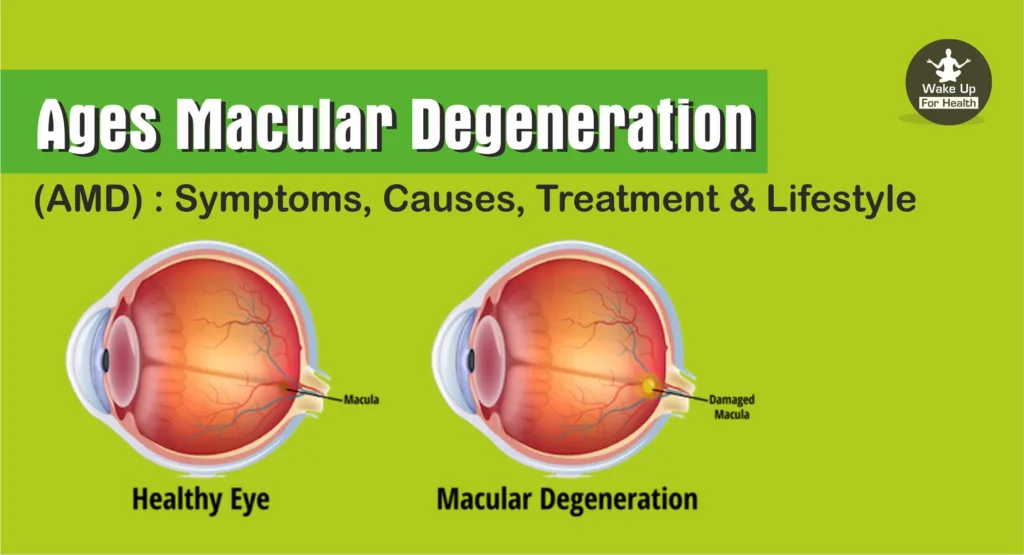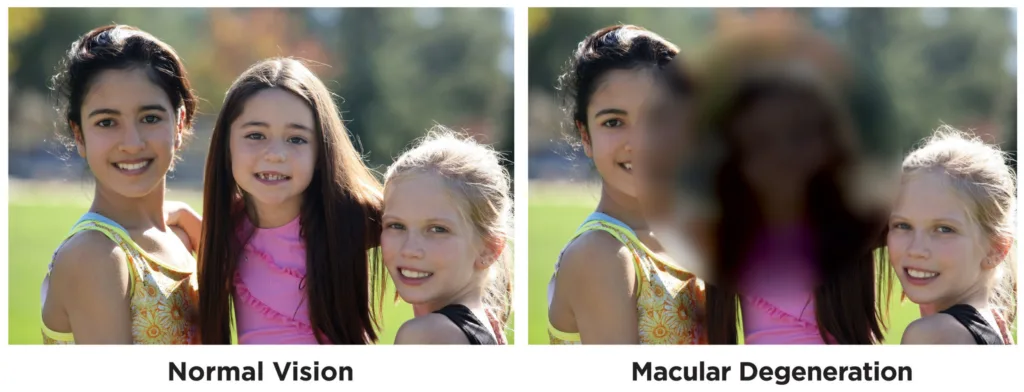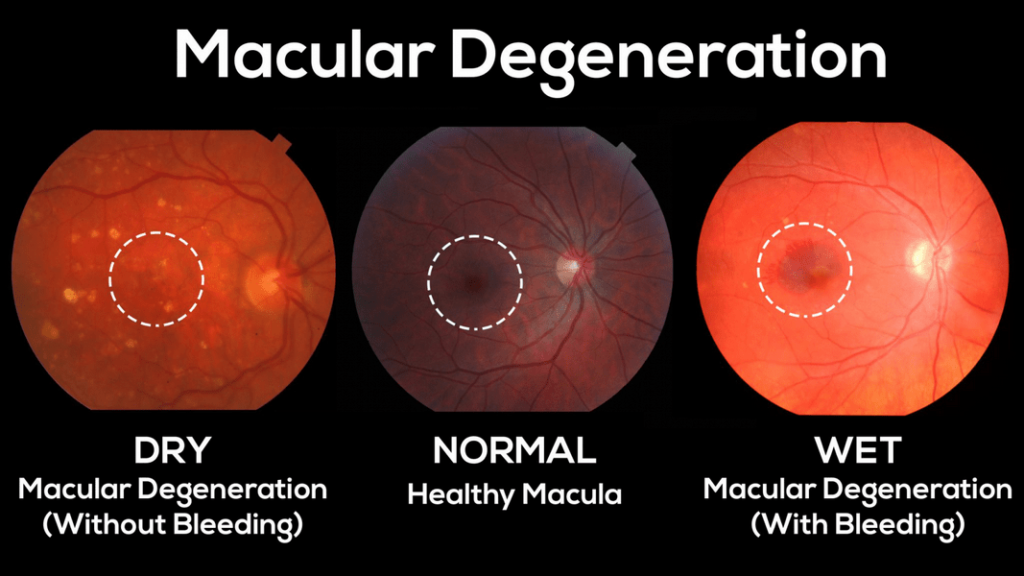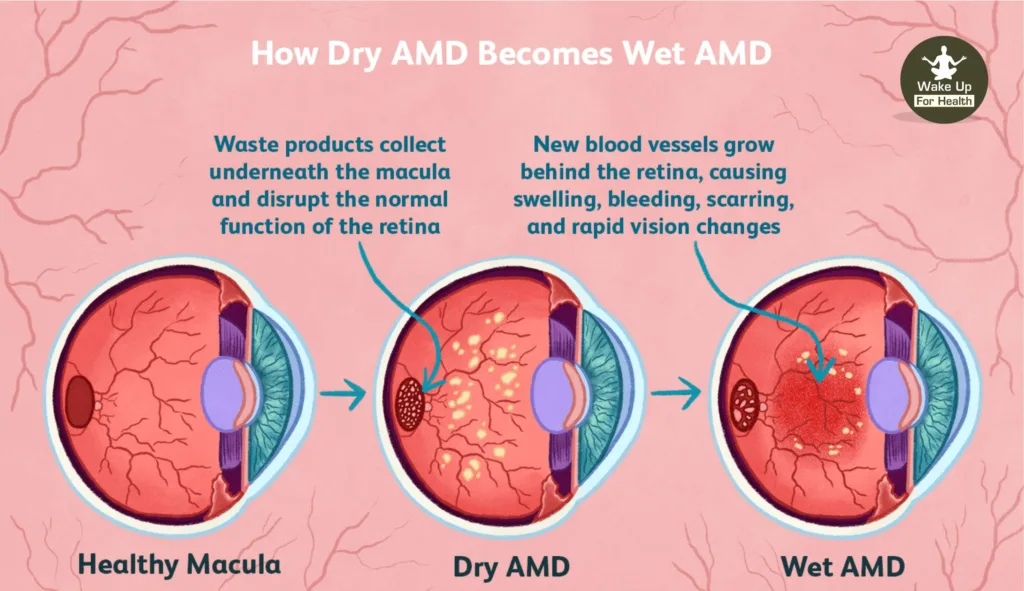The most common cause of serious vision loss in persons over 50 is macular degeneration (AMD). In addition, women are more likely to develop AMD than men because the disease tends to develop at a particular age in a person, also known as age-related macular degeneration (AMD).
What is Ages Macular Degeneration?, Navigating AMD

An ongoing eye condition is macular degeneration. In the centre of the retina is the macula. The macula is a thin layer of sensitive tissue at the back of the eye. Because of the macula, we can see directly in front of the eye. Age-related macular degeneration is another name for macular degeneration (AMD). When the tissue of the macula gets damaged, we get macular degeneration disease. Due to this, we cannot see the object between the eyes clearly.
For example, you are looking at the watch on your hand. In the case of macular degeneration, you will not see the center of vision clearly. In most of the elderly, blindness comes from damage to the macula. However, by identifying it at an early stage and with the right treatment, eyesight can be preserved.
What are the Symptoms of Macular Degeneration?, Symptom Awareness, Lifestyle Modifications

There are no visible signs of AMD in the early stages and until it affects both the eyes. Till then this disease cannot even be identified. Blurred vision is frequently the first sign of macular degeneration.
Symptoms of AMD include:
• Loss or worsening of clear vision. You may have blurred vision.
• Difficulty reading small print and driving.
• Darkness and blurred vision between the eyes.
• Things appearing crooked.
• Making everything seem closer and more away.
• Difficulty seeing in dim light.
• Loss of intensity or brightness of colors.
• Problems with face recognition.
• Blurring of objects.
• Difficulty reading letters.
• Lack of focus in vision.
• Presence of Darkness in the Center of Vision.
If you experience any of these symptoms, see an eye doctor as soon as possible.
There are 17 Types of Heart Diseases?
What are the Caused of AMD?
As mentioned earlier, AMD is more common in adults over 40, but it becomes the leading cause of severe vision loss in adults over the age of 60. The problem of macular degeneration can be hereditary. This means that the disease can be passed from parents to children. If someone in your family has this disease, then you too can get this disease. Consult your eye doctor to avoid this risk.
Other causes of AMD-
• Obesity
• Smoking habit
• Age above 50 years
• Complaint of high blood pressure
• Have a family history of AMD
• Having a heart condition increases your chance of developing AMD
What are the Types of Age related Macular Degeneration (AMD)?

1. Dry AMD.
The “Dry” form of macular degeneration is characterized by the presence of drusen, a yellow deposit, in the macula. A few small drones may not cause any damage to vision, but as they grow in number and size. They start proving harmful for vision. In the early stages of this form, there is a thinning of the light-sensitive layer of cells in the macula.
This causes the death of tissues. In the atrophic form of AMD, patients develop blind spots in the center of their vision, and in the advanced stage of AMD, patients lose their central vision.
2. Wet AMD.
The “wet” form of macular degeneration is caused by the growth of abnormal blood vessels from the choroid beneath the macula. This is called choroidal neovascularization. These blood vessels leak blood and fluid into the retina, causing vision loss and making straight lines appear distorted and wavy.
Along with this the patient has blind spots and loss of central vision. These aberrant blood vessels and the haemorrhage they cause eventually scar and impair central vision permanently.
How you can cure your Type-2 Diabetes?
As mentioned earlier, most patients have the dry form of the disease and this often causes patients to lose some part of their central vision, yet one should note that the wet form of macular degeneration Could also be AMD. Although only 10% of people with macular degeneration develop the wet form of AMD.
How to Diagnose Macular Degeneration?
• Macular degeneration can be detected with regular eye exams. Initially, a small yellow mole is seen in the center of the retina. It can be detected during regular eye examination.
• Your physician could request that you view an Amsler grid. It is a pattern of straight lines, which looks like a checkerboard. Some of these lines can be seen waving to you. Also you may see some lines missing. These types of signs can be symptoms of macular degeneration.
• Angiography or OCT may be advised if symptoms of age-related macular degeneration are seen. In angiography, the doctor will inject dye into a vein in your arm. Pictures are taken of the dye as it moves through the veins in your eye. If during this time new blood vessels are seen leaking fluid or blood into the macula, then its place is known. Also, at which place it is leaking, this information is also clearly available.
• It can be detected through OCT without dye or blood in the retina. Regular check-ups are necessary to detect macular degeneration at an early stage. Proper timely treatment slows down the complications in this problem.
What is the Treatment of AMD?

There is currently no cure for “dry” macular degeneration and the loss of central vision cannot be reversed, but the disease can be treated if detected early enough. . This treatment can prevent this disease from taking a serious form. It can also significantly slow the progression of the disease. Other than this the treatment options available are as follows:
• Anti-Angiogenesis Drugs
These drugs (Aflibercept, Avastin, Eyelet, Lucentis, Macugen) prevent new blood vessels from growing and prevent leakage from abnormal vessels within the eye that cause wet macular degeneration. This treatment has brought a big change in the treatment of this disease. Many patients have actually regained their lost sight with the help of this treatment. Treatment may require follow-up.
• Laser Therapy
This treatment works by destroying the actively growing abnormal blood vessels. It uses high-energy laser light to destroy abnormal blood vessels.
• Photodynamic Laser Therapy
This is a two-step treatment. It contains a light-sensitizing drug (Visudyne). Which is used to damage abnormal blood vessels. During this treatment, your eye doctor injects a drug to be absorbed by the abnormal blood vessels in the eye, then shines a cold laser into the eye to activate the drug and damage the abnormal blood vessels.
Do you know Sid Effects of Keto Diet?
• Low Vision Aids
These devices include special lenses and electronic systems. These devices help in making enlarged images of nearby objects. These devices help people who have lost their vision from AMD. They are better able to utilise their remaining vision as a result.
Some new treatments for macular degeneration are also being discovered and all of those treatments are still in the experimental phase.
• Sub-Macular Surgery
Surgery to remove aberrant blood or blood vessels.
Retinal Translocation.
This involves destroying the abnormal blood vessels that lie directly below the center of the macula, where a laser beam cannot be placed safely with surgery. During surgery, the macular center is routed from the abnormal blood vessels to the healthy area of the retina. This helps prevent the formation of scar tissue and damage to the retina. Once the abnormal blood vessels have moved away, laser treatment is used to remove the abnormal blood vessels.
Lifestyle Changes that can Help you Reverse Macular Degeneration.
Macular degeneration can be prevented in the following ways:
• A healthy lifestyle reduces the risk of developing macular degeneration.
• Its prevention is possible by taking a healthy diet including green leafy vegetables, fish.
• Quitting smoking is considered a major step in the prevention of macular degeneration.
• Keeping high blood pressure under control.
• Keeping the weight at a normal level.
• Regular light exercise on a daily basis reduces the risk of macular degeneration.
(Disclaimer: This article is for general information only. It is just to wake you up for your health purpose. Out intension is not to mislead or It cannot in any way be a substitute for any medicine or treatment. Always contact your doctor for more details.)
1 thought on “Macular Degeneration (AMD) : Symptoms, Causes, Treatment & Lifestyle”